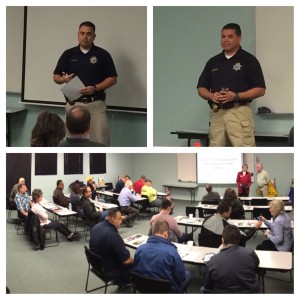 Presenters: Greg Cupper, President of EcoFleet Training Solutions and Officers Guillermo Garcia & Ralph Cervantes, California Highway Patrol
Presenters: Greg Cupper, President of EcoFleet Training Solutions and Officers Guillermo Garcia & Ralph Cervantes, California Highway Patrol
Topic: Winter Safe Driving
On Thursday December 3 at 8:30am, Safety Center hosted its monthly Safety Forum on the topic of “Winter Safe Driving” to address the challenges of driving in tricky winter weather conditions. During this month’s forum, Greg Cupper of EcoFleet Training Solutions and Officers Guillermo Garcia & Ralph Cervantes of the California Highway Patrol comprised the expert panel for discussing this timely and controversial topic. 25 safety professionals participated in a lively discussion regarding the rights of employers to implement and maintain a drug-free workplace.
The presentation summary is as follows:
Getting Drivers Focused
- Include winter driving information in newsletters
- Conduct safety meetings on winter driving
- Provide useful take-away information
- Include winter driving survival information via employee email or other means
- Train drivers how to recognize winter driving hazards, such as snow and ice-covered roads
- Train drivers on the safeguards they should take in winter driving conditions
- Create and enforce driver safety policies such as when or when not to drive based upon conditions
- Tips for drivers include:
- Make sure fatigue is not a factor when driving
- Don’t use cruise control in inclement weather
- Make sure when traveling to have at least a half tank of fuel
- If you become snow-bound, stay with your vehicle
- Make sure the exhaust pipe isn’t clogged with snow, ice or mud
Example: Skid Control
- Continue to look at your path of travel down the road
- Steer in the direction you want the front of the vehicle to go
- Avoid slamming on the brakes. Slamming the brakes wil only futher upset the vehicle’s balance and make it harder to regain control
- When the rear wheels stop skidding, continue to steer to avoid a rear-wheel skid in the opposite direction
Best Practices Fleet Preparation
- Service up-to-date
- Check battery
- Check coolant system
- Check wipers and defrosters
- Verify proper floor mat installation
- Inspect tires (i.e. damage, deterioration)
- Ensure proper inflation
- Replace with all-weather tires
- Check wiper blades and fluid
- Ensure vehicles have an emergency kid
Elements of a Winter Driving Emergency Kit
- Shovel, broom, ice scraper
- Blankets
- Abrasive Material such as Kitty Litter
- Jumper cables, flashlight, and warning devices such as flares and emergency markers
- Chains
- Food, water & change of clothes
- Cell phone charger
- Flashlight
- Extra batteries
- First aid kit
Using Technology to Avoid Skids
- Familiarize drivers with new safety features
- Remember not to pump the brake with anti-lock braking systems
- Use “Plant and Steer” with ABS
- Make sure ESC (Electronic Stability Control) is on
Information Sources
- Safercar.com
- AAA Youtube Channel
- California DOT
- Caltrans Highway Information Network: 800.427.7623
Best Practices – Next Steps
- Review existing components of your driver training/safety program and “tune-up” as indicated
- Audit prior collisions/incidents to determine root causes including those related to winter inclement weather
- Implement effective training using best practices programs
- Desired Outcome: Develop an effective and comprehensive best practices fleet winter driving safety program
Goal:

